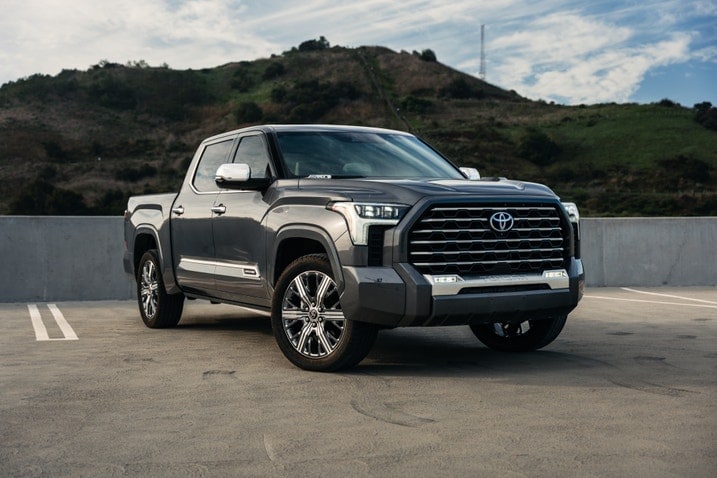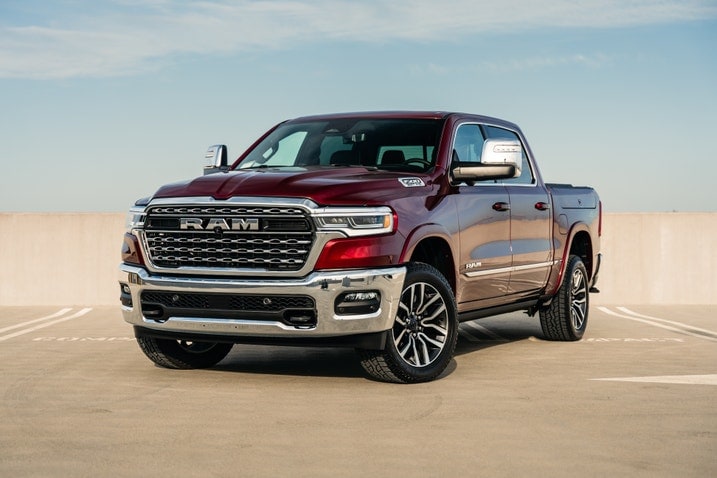- We put all five full-size trucks currently on sale into a battle royale.
- Some of these pickups were updated more recently than others, and it shows.
- Each of these trucks has different strengths and weaknesses for you to consider before buying. We'll detail them all.
Ford F-150 vs. Chevy Silverado vs. GMC Sierra vs. Ram 1500 vs. Toyota Tundra: Every Full-Size Truck Compared
Finding the best full-size truck is no midsize task
Before reading this comparison test (and watching the video), you might already have a favorite full-size truck. This is one of the most highly competitive segments in the U.S., and with several of these trucks having recently been updated, we decided it was time to compare the good, the bad and the ugly once again. Enter the ring, five fierce full-sizers: the Chevy Silverado, Ford F-150, GMC Sierra, Ram 1500 and Toyota Tundra.
We're going to use the Edmunds rating system to help explain the pros and cons of each truck, but we'll also hand out a wildcard to each pickup as well. Why? All of these trucks are good, and there are specific reasons why you might want to consider buying one over the other. So, let's rank these trucks from bottom to top, with the overall Edmunds Rating climbing as we go.
5th place: Chevy Silverado
Edmunds Rating: 7.5
The good: Technology
The Silverado's last full redesign came all the way back in 2019, with a refresh in 2022. Even so, it's got the largest standard touchscreen of any of the trucks in this group (along with the closely related GMC Sierra), at 13.4 inches. And we also really like what's powering the screen, with an infotainment system that has deep Google integration and lets you use Google Maps as the default navigation app and the Google voice assistant to answer natural speech commands. This means that, if you log in to your Google account, you can get all of your places, contacts and preferences loaded right into the truck, and you can even download apps from the Play Store like Spotify or Audible. On top of that, higher trim levels also offer the hands-free Super Cruise highway driving system — our favorite example of this tech.
There is a downside though: subscriptions. After a three-month trial period, you'll have to pony up for a data plan to power that Google stuff. And if you have Super Cruise, that'll require a subscription as well.
The bad: Comfort
This manifests in two ways: the seats themselves and overall ride quality. The front seats are too firm and flat, so they lack both comfort and support. On a long trip, they get uncomfortable pretty quickly, and you'll find yourself squirming from time to time to try to get settled unsuccessfully. In the back seat (of the crew cab) there's a lot of room for passengers or cargo, but the cushions are even firmer and the seatback is set too vertical with no way to adjust it. On top of that, the ride quality is very busy. Even if you account for the "truckier" expectations of a big body-on-frame pickup, the ride still sucks. Small and large bumps alike upset the suspension and make the cabin bounce around, more so than any of the other trucks tested here.
Wildcard: Going off-road for less money
The Silverado is offered in several off-road trims — everything from the Z71 Off-Road package to the even more capable Trail Boss and ZR2. If you line these up with the off-road trims of the other trucks, it becomes clear that you're getting nearly the same capability for a significantly lower price. Take our latest full-size truck off-road challenge as an example, which pitted the Trail Boss with the diesel powertrain up against the Ram 1500 Rebel and Ford F-150 Tremor. The Chevy came in at just $68,550, well below the prices of the Ford ($81,865) and Ram ($81,835).
4th place: GMC Sierra
Edmunds Rating: 7.6
The good: Interior
The Sierra and Silverado share many interior components, but since our test vehicle is a Denali Ultimate trim, the materials and overall quality take a giant leap. Supple leather upholstery and open-pore wood adorn much of the cabin, along with a ton of chrome (which is a bit too flashy for our tastes). Is this the most luxurious interior of the bunch? No, that distinction still belongs to the Ram (more on that later). But what's inside of the Sierra is still quite impressive, and thankfully, it's got much better seats than the Silverado.
The bad: How it drives
This isn't due to its powertrains; the optional 6.2-liter V8 found under the hood of the Sierra we tested is pretty awesome both audibly and when it comes to getting the big truck up and moving. It's the stopping that's a problem. Braking power isn't an issue; the Sierra stops in about the same distance from 60 to 0 mph as the other trucks (138 feet in our testing), but the brake pedal feels almost wooden and has a big dead spot at the top of its travel. As a result, it's tough to modulate the amount of pressure you're applying, and with all of that weight moving around, it is difficult to stop smoothly (even after plenty of practice). The Denali Ultimate also comes with an adaptive suspension that doesn't quite work as intended; it's a bit too stiff for everyday driving, and bumps will jostle everyone in the cabin.
Wildcard: Powertrain diversity
Admittedly, this could be a strength for both the Sierra and Silverado because they have the same engine options. But the fact remains that if you want to get a diesel engine in a light-duty truck, the GM twins are the only way to go. On top of that, there's a base turbocharged four-cylinder and you can double the cylinders to choose from a pair of available V8s (5.3-liter and 6.2-liter options). The diesel remains notable for its fantastic low-end torque delivery and fuel economy, which also means you get incredible range: up to an EPA-estimated 624 miles with two-wheel drive.
3rd place: Toyota Tundra
Edmunds Rating: 7.9
The good: Technology
The cabin's centerpiece is a 14-inch touchscreen, which is standard on all but the base two Tundra trims. It doesn't have the same Google integration that the GM trucks, but the navigation system does pull in points-of-interest (POI) data from Google so you get updated locations/ratings regularly. We are also big fans of the wireless Android Auto and Apple CarPlay integration because they take up the whole screen and look fantastic. There are plenty of standard advanced driver aids as well, with adaptive cruise control plus lane centering that works all the way down to a stop, in addition to automatic high beams and road sign assist. Unfortunately, the Toyota is also the only truck in our test to not offer some sort of hands-free driving system.
Watch out for subscriptions with the Tundra as well. It requires separate ones for the navigation/voice commands or any music streaming services, so it's not even a single data package. Using your phone as a hotspot isn't an option either. This subscription trend is getting out of hand.
The bad: Fuel economy
In our time with the Tundra we noted only 15.2 mpg, well below the estimated 19 mpg combined that's estimated for four-wheel-drive versions. And unfortunately, the same rings true for the Tundra Hybrid. It has the roughly the same fuel economy estimate as the gas models, but we noted similar results in our time with the truck, meaning you won't be able to make up the hybrid's additional cost in fuel savings.
Wildcard: Well rounded
This is a very solid truck with no great deficiencies when it comes to performance, comfort or day-to-day livability. Though it fails to reach the same heights as the two remaining trucks, we still think people will be happier with a Tundra in their driveway than either of the GM trucks.
2nd place: Ram 1500
Edmunds Rating: 8.1
The good: Comfort
The Ram is arguably the best-riding pickup you can buy. There are times when you honestly forget that you're driving a truck, as it dismisses potholes and road seams with impunity. Higher-end models like this Limited come with an auto-leveling four-corner air suspension, which helps with ride quality but also means the truck can lower itself to make getting in and out easier.
Beyond the ride itself, the Ram's cabin is next-level nice. Our test truck is a Limited and it feels (and looks) nicer than even the Denali Ultimate. Still not nice enough? Check out the Ram 1500 Tungsten, which is mega fancy. Both the front and rear seats are fantastic, and there's no shortage of creature comforts.
The bad: Technology
The Ram has the largest screen of any truck here, measuring 14.5 inches. But its size is the only real advantage. Vertically orienting these large touchscreens isn't usually a great choice, as other automakers (including Ford) have tried it and switched back to horizontal soon after. Ram has moved many commonly used controls into the screen, like the seat heating/ventilation and the towing settings. But the problem is that the screen itself is laggy and sometimes just doesn't seem to respond to inputs at all, so you end up double or triple pressing something until it reacts. The surround-view camera system also appears tiny on the screen, and if you use Android Auto, it takes up only about half the screen. (Apple CarPlay does look much better.) This display is a definite disappointment given how appealing the rest of the interior is.
Wildcard: Performance
In its latest update, the Ram 1500 dropped its V8 engines entirely in favor of a pair of straight-six turbo engines. But this proves to be addition by subtraction because these engines absolutely rip. A Ram 1500 Tungsten with the high-output version of the engine screamed from 0 to 60 mph in just 4.7 seconds, a time that is quicker than vehicles like the Toyota GR Corolla. And with the "standard output" version of the same engine, a Tradesman wasn't far behind, with a time of only 5.2 seconds. Seeing those big trucks fly down our drag strip was a pretty awesome sight, especially when you consider that the Tungsten tips the scales at nearly 6,000 pounds. Yes, we do admittedly miss the noise and drama of the V8. But when it comes to getting moving, you won't miss a thing.
1st place: Ford F-150
Edmunds Rating: 8.2
The good: Technology
It was hard to narrow this down to one thing, because the Ford has best-in-class towing/payload and does just about everything well. But this particular category is worth highlighting because it's where the F-150 really bests the Ram 1500. A 12-inch screen is standard across the entire F-150 lineup, and it's fantastic to use with a simple menu structure, the best surround-view camera of the bunch, and a navigation system that doesn't require a subscription. (Imagine that.) Ford has also (thankfully) resisted the urge to throw all of the controls into the screen, meaning are well-placed controls around the center console for commonly used functions including our personal favorite, a camera button. On top of that, you can also get the BlueCruise hands-free driving system that has markedly improved over time and a really good set of towing technology aids. And there's of course wireless connectivity for Android Auto and Apple CarPlay, with both taking up the entire screen. Kudos to Ford for making life easy.
The bad: Design
In part due to its popularity, the F-150's styling doesn't exactly stand out as much on the road as the brawny GM twins or the angular Tundra. And its interior trappings, though nice, don't quite give you the same wow factor as the Ram. Are we nitpicking? Undoubtedly. But when a truck is this good from the get-go, we have to dig into the details.
Wildcard: Off-road capability
Even though you can go off-road cheaper in a Silverado, it can't match the Ford's capabilities. There are of course the desert-running Raptor and Raptor R that top off the Ford lineup, with the Raptor R taking down the Ram 1500 RHO in a head-to-head battle. But as you move down the ranks, the F-150 Tremor can't be ignored, as it defeated the Ram 1500 Rebel and the Silverado 1500 Custom Trail Boss recently in a different off-road showdown. It's clear that Ford makes the best truck for both work and play.
Photos by Ryan Greger











 by
by  edited by
edited by